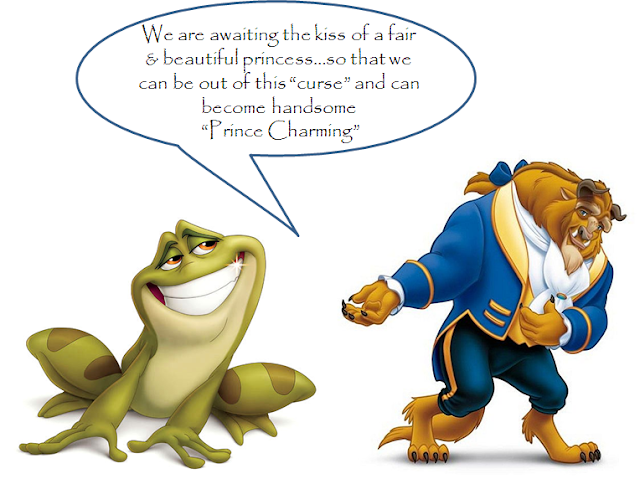Well I took
some time in writing this post as it required some research on my part. The
analysis & conclusions I was getting on net were ranging from somewhat
logical to downright ridiculous (or so I think), however reading up on Grimm
Brothers helped. I referred to some blogs, some write-ups on fairytales &
saw snippets of a couple of documentaries available on YouTube.
In my last
post, I had made a point about mothers today, who have themselves grown up
reading & loving fairy tales, but do not prefer to introduce their children
to the same. The reasons they gave were “stereotype clichés” that most fairy
tales were associated with. I dug deep into Grimm Brothers to find whether
these factors were really accounted for by the legendary authors when they spun
these stories for the first time.Well, the stories were actually, NOT spun by the Brothers themselves, but were carry forward folktales. These folktales mainly originated in Europe, & in Europe, mainly in France & Germany. The Brothers’ themselves, though German, were more influenced by French folklores & literature. Some of the stereotypes you often stumble upon in Grimm’s tales are:
WICKED STEPMOTHERS & UGLY
STEPSISTERS & Wicked Old Witches: Really??!! In all of their stories save Rumplestiltskin
(who by the way is painted as a dwarf), all wicked villains are stepmothers
& stepsisters. Men are generally spared in their stories. A little research
of the era the brothers grew up in, related a possible conclusion why it was
so. The society at that time greatly disliked the concept of stepfamilies, and
it was assumed that a stepmother would often keep her stepchild (especially
daughter) in an unkind situation. This was although not just a European notion,
but was also seen in Chinese folklores. Probably putting the blame on a
stepmother helped too, as not being attached to the child by blood, they became
easy scapegoat as villains of the story.
The
stereotypical portrayal of a Witch was generally as an old wrinkled woman
living alone. In countryside life, women who lived alone & were extremely
old, were often recluse (& naturally short tempered because of their
loneliness, age/illness & little work to do at their disposal), therefore
they were often painted as wicked witches who lure kids & eat them. A
little study of society reveals that single women were highly looked down upon
in society at large at that time. Hence if a woman was living alone, and kept
to herself, she was often branded as a Witch (!!)
WITCHCRAFT: Thank God for J.K.Rowling. The
woman finally ensured that people understand that Witchcraft does not
necessarily mean Evil. Witchcraft has always been equated to Evil in all
folklores across the World. Of course folklores had fairy godmothers too, but
they had Witches in good measure in almost all stories. The theory at that time
was, that anything unexplainable or paranormal should be branded as Evil
Witchcraft. Grimm stories have only cemented this belief to this day.
UGLY turning to LOVELY with True Love’s
First Kiss: The
makers of Shrek had a field time with this one. The Brothers Grimm fast
forwarded & painted a very common notion world over – if ugly then cursed
& if lovely then blessed. They did make virtues a mirror of how a person
looks. So if the stepmother & stepsisters are ugly, they are cruel &
bad tempred; if the princess is a virtuous woman, she is gorgeous to look at. Yes
I do get the symbolism behind these tales, but we cannot deny the fact that
such stereotypical notions have carried forward to this age & have created
a constant pressure on people towards “looking good”. The frog changes to
handsome Prince Charming with a kiss; so does the Beast in Beauty & the
Beast.
In another vein, and at the cost of sounding stereotypical, a very
European notion was (& is prevalent even now) “Fair is Beautiful”. So
fairies were fair, princesses were fair, maidens were fair, and the queen in
Snow White & Seven Dwarves says “Mirror mirror on the wall, Who is the ‘fairest’ of them all”. Fair was equated
with good, and dark, old, wrinkly was equated with wicked witch.
If I compare
Grimm Brothers with Panchatantra (the Indian folklore tales), the latter told
stories through animals as characters, generally to avoid major stereotypes in
caste, sex etc. That is not to say that they did not have their own set of preconceived
notions (all these stories ended with a Moral of the Story and generally
encouraged readers to follow a set system of beliefs), but those were less in
impact on clichés when compared to Grimm Brothers’ tales. I have definitely enjoyed all tales from the duo & cannot deny that they are an integral & undying part of my childhood (and of practically everyone), but after researching & writing this post, I agree with new age mothers, who are not willing to expose their children to age old clichés & stereotypes, that might cement their impressionable minds towards some notions that are not meant to be.
The charm of Grimm Brothers and their stories will continue, but we need to look beyond the Glass Slipper, so that these tales can live on forever.




Lovely
ReplyDelete....................
Dép cói đi trong nhà